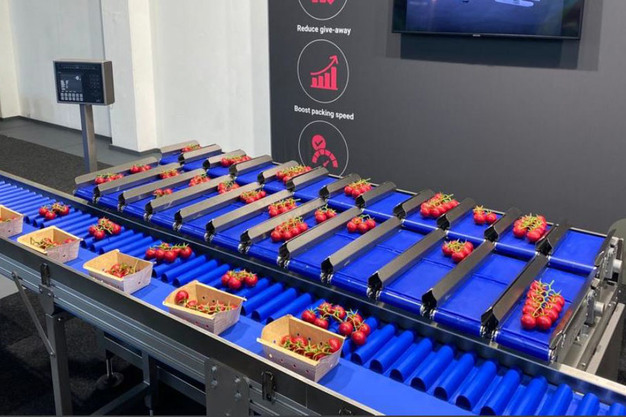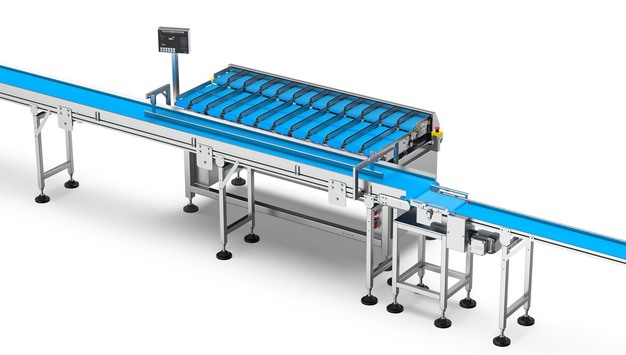"Automation is in demand everywhere. There's a labor shortage in the current market, and getting quality people is hard. It's tricky to find the right people for a certain place. Companies are, thus, genuinely looking for innovations that allow them to save 'hands'," begins Roel Borgman of LRE Weegtechniek, explaining the impact of the current job market. This Dutch company supplies weighing technology and related software worldwide.

He says that for fragile products, like TOVs and grapes, where much, such as cutting and packaging, is still done by hand, automating the weighing process can prove highly beneficial. That is why his company developed a semi-automatic multihead weighing line. "After extensive testing, it will soon be launched."
Labor-saving
Efficiency is the name of the game. According to Roel, this new semi-automated weighing solution achieves that because its operator focuses on one specific task. "They have a single job, not four or five, so they can do it far more efficiently. Reducing the number of operations saves a lot of time. It also accelerates training paths," he says.
Working method
Roel explains that with the new multi-head weighing line, one or two operators pre-fill empty packages with the product up to, say, 80% of the desired weight. "They place these on the infeed conveyor, and a weight checking belt weighs them. The machine uses that weight to make combinations as close as possible to the target weight."
He points out that they deliberately opted to equip the machine with 12 weighing belts and, behind those, 12 buffer belts, with two positions each. "There are, therefore, 36 places on the machine for possible combinations. The additional built-in buffer ensures a calm, rapid filling process and extra weight accuracy," says Borgman.
Two operators snip the TOVS as per quantity specification and feed the 12 weighing belts, he explains. "From there, the trusses are automatically transported to the buffer belts, and the combinations can begin to be made. When such a combination is made with the pre-filled containers, the machine ensures the correct bunches automatically end up next to the packaging on a discharge conveyor."
Then, an operator only needs to place that bunch into the tray that is at the correct weight. "The buffer belts' compact layout means the line can reach high combination speeds with a low output belt speed. That's important because it ensures the person placing the bunches into the package can do so at a manageable pace, without unnecessarily missing them," Roel continues.
Less give-away
Besides saving on labor, this machine saves on weight, too, he adds. "If you can save a little on each package, that's a lot of money annually: six grams on a small 200 g package times, say, 40 trays per minute, times 60 minutes, times eight packaging hours per day, times five days, yields a substantial savings of give-away."

Another benefit of having fewer workers is that you need less space. Roel says the semi-automatic multi-head weighing line easily fits into existing packing lines. "It's compact; ultimately, you can do the same or even more in less room. The company can, then, use its space differently. A traditional packing line has more people who need space to work. With the semi-automatic multihead weighing line, you need fewer people, so the line takes up far less room," he says.
Semi-automatic
When designing this machine, LRE deliberately chose it to be semi-automatic. "A fully automated process is somewhat less flexible. It's often specific to the continuous processing of one type of product. Semi-automatic solutions are more similar to what a company already does," Roel adds. "That makes it easier to integrate them into existing processes. You can, thus, retain the 'hands-on' added value but need far fewer actual people."
"The machine lets you display all the weighing data in an online software app." Then, says Roel, you can track production performance at the site, batch, product, or line level. "Data examples include things like speed, giveaway, number of pieces, and total weight. You can view that information on a computer, phone, or tablet in graph and table form. Plus, an optional API connection allows you to retrieve the weighing data to use in your own reporting system," he concludes.
Roel Borgman
[email protected]  LRE Weegtechniek
LRE Weegtechniek
Satellietbaan 15G
2181 MG, Hillegom
+31 (0)252 532436
[email protected]
www.lre.nl
